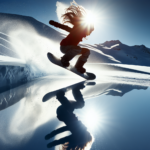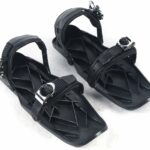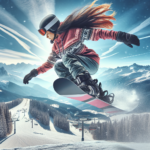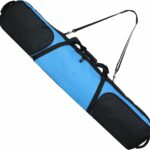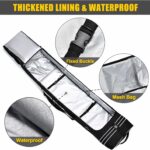Are you ready to escalate your snowboarding experience? In this guide about “How to Jump On Snowboard?,” you’ll discover how to execute the perfect jump on your snowboard. You will learn the techniques, tips, and tricks you need in taking those first leaps of faith from the snow and soaring into the winter sky. This guide will instil confidence in you as you prepare to make the transition from the ground to the air with your snowboard and carve new memories on the slopes.
Understanding the Basics of Snowboarding
If you’re bitten by the snowboarding bug, then welcome to an exhilarating journey. Snowboarding isn’t simply about flashy stunts or daring downhill descents. It is a delicate marriage of skill, determination, balance, and instinct. Let’s start from the very start – the basics.
The Importance of Basic Snowboarding Skills
Every master snowboarder began at the same starting point: the basics. Getting them right helps your overall performance. Think of it this way, if you were building a house, you would need a sturdy foundation and the same logic applies to snowboarding. The basic skills are your foundation.
Getting Comfortable on Your Snowboard
To perform well, you need to be comfortable on your board. This means familiarizing yourself with its feel beneath your feet, how it moves, and how you control its movements. The more comfortable you are, the more confidence you develop in your abilities to guide it.
Understanding Snowboard Equipment
Understanding your snowboard equipment can make a world of difference in your performance. This includes everything, from your snowboard to your bindings and your boots. Each piece of equipment serves a purpose and contributes towards your overall snowboarding experience.
Physical Preparation for Snowboarding Jumps
Snowboarding is as much about physical prowess as it is about skills. Your physical wellbeing has a direct impact on your snowboarding performance, affecting everything from your energy levels to your balance, strength, and resilience.
Exercises to Improve Snowboarding Skills
Regular exercise not only keeps you physically fit but also improves your snowboarding skills. Cardiovascular exercises like running or cycling can enhance your stamina, while strength training can improve your core stability and leg strength, both essential for good snowboarding.
Nutrition Tips for Snowboarders
A balanced diet can help snowboarders to build the necessary energy and capacity for their runs. Carbohydrate-rich foods like pasta offer quick energy, protein helps in muscle recovery, and vitamins and minerals contribute to overall health. Hydration is also important, so drink lots of water.
The Role of Flexibility in Snowboarding
Flexibility is crucial in snowboarding. It helps in maintaining balance, executing tricks, and even in preventing injuries. Regular flexibility training such as yoga or stretching exercises can help to boost your performance.
Mental Preparation for Snowboard Jumps
Snowboarding is also a mental game. The strength of your mind and your mental preparation play as big a role in your success on the slopes as your physical condition and technical skills.
Importance of Mental Preparation
Being mentally prepared helps to keep your mind sharp, focused, and in control, even when faced with challenging runs or tricks. It instills a sense of calm and confidence, protecting you from panic or hesitation on the slopes.
Visualization Techniques
Visualization techniques can help you mentally rehearse your snowboarding jumps. Imagine every movement in your head, visualize your jump realistically to prepare yourself for the real experience.
Overcoming the Fear of Jumps
Fear is more common than you think in snowboarding, especially with jumps. Addressing your fear directly, understanding it, and developing techniques to cope with it are important steps in overcoming it and enhancing your performance.
Choosing the Right Conditions for Jumping
Just like surfing relies on the right waves, snowboarding jumps depend on the right conditions.
Checking Snow and Weather Conditions
Check the snow and weather conditions before you plan to jump. The quality of the snow can greatly impact your speed, control, and landing.
Understanding Terrain Park Etiquette
You are not alone on the lines. Other skiers and snowboarders will be around, hence understanding and respecting terrain park etiquette is crucial. It ensures a safer and more enjoyable experience for everyone.
How Different Snow Conditions Affect Jumps
Different snow conditions can drastically affect your jumps. For instance, soft, powdery snow may provide a softer landing, while icy, compact snow may increase your speed. It’s essential to understand these differences.
The Approach to the Jump
The approach to the jump plays a crucial role in executing it successfully.
Conducting a Speed Check
Before attempting to jump, perform a speed check. Too much speed can send you flying uneasily, while too little speed might not get you off the ground.
Practicing the Correct Stance
Having the correct stance as you approach the jump is vital. Your knees should be slightly bent, weight centred, and eyes focused on the path ahead.
Choosing the Appropriate Take Off Spot
Identify your take-off spot well in advance. It should be a site free from obstacles, where you have enough space to gain speed and perform the jump.
Executing a Snowboard Jump
The execution of a snowboard jump comprises few crucial steps.
Mastering the Pop Technique
The pop technique might seem simple, but it forms the crux of most snowboarding jumps. The trick is to apply the right amount of pressure and timing to get your jump just right.
Maintaining Balance During the Jump
Maintaining your balance during a snowboarding jump can be tricky. As the ground leaves your feet, your body needs to adjust to maintain equilibrium. Keep your body straight and your shoulders parallel to the board for best results.
The Role of Knees in Snowboarding Jumps
Your knees play an essential role during jumps. They act as your body’s natural shock absorbers. Your knees also help in controlling the height of your jumps, the rotation, and easing your landing.
Landing a Snowboard Jump
Landing a snowboard jump might be the most exciting and nerve-wracking part of the trick.
Sticking the Landing: Techniques and Tips
To stick your landing, you need to keep your eyes on the landing spot. Your knees should be slightly bent and your body weight centred.
Common Mistakes to Avoid When Landing
There are a few common mistakes to avoid when landing. Don’t look down at your board or keep your body stiff. Avoid leaning too far back or too far forward.
The Role of Knees in Landing
Just as with jumps, your knees play a crucial role in landing as well. They help absorb the landing impact and provide stability, reducing the risk of injury.
Safety Considerations While Jumping
Safety should always be a priority when snowboarding.
Importance of Safety Gear
From helmets to wrist guards, the right safety gear can protect you from potential injuries. Never underestimate its importance.
When to Bail from a Jump
Learning when to bail from a jump can save you from dangerous falls. If mid-air, you realize something isn’t right, it’s important to know how to safely abort the jump.
Dealing with Falls and Injuries
Falls and minor injuries are part of snowboarding. Knowing how to properly fall and dealing with minor injuries can prevent more serious problems.
Practicing Jump Techniques
As with any skill, becoming proficient at snowboarding jumps requires a good amount of practice.
Practicing on Smaller Jumps
Begin by getting comfortable with smaller jumps. They may not be as thrilling, but they are the perfect playground to learn and master the basics.
Building Up to Larger Jumps
Once you’ve grown comfortable with smaller jumps, gradually work your way up to bigger ones. This slow build-up not only makes the learning process less daunting but also safer.
Incorporating Spins and Tricks Into Jumps
Once you’ve mastered the basic jump, you can start incorporating spins and tricks to add style to your jumps. However, always ensure you are confident and comfortable with these new additions before attempting them.
Tips for Improving Jumping Skills
Improvement in any aspect of snowboarding doesn’t come overnight. Here are a few tips that can help you in improving your jumping skills.
Learning from Others: Snowboarding Lessons and Tips
Lessons from professionals can provide valuable insights and tips to improve your jumping skills. Also, watching other experienced snowboarders can inspire and teach you more about the art.
The Role of Persistence in Learning Snowboarding Jumps
Persistence is key. There will be falls, there will be mistakes, but don’t let them get to you. Keep practicing and you’ll see improvement.
Utilizing Video Analysis for Improvement
Record your jumps and analyze them. Video can give you a different perspective, helping you to spot mistakes and areas for improvement that you wouldn’t notice otherwise.
Jumps are a key part of snowboarding. They test your athleticism, encourage creativity, and raise the thrill of the ride. As you learn and improve, you’ll find each jump more exciting and rewarding than the last. Happy jumping!
- What Snowboard Bindings Should I Get? - January 23, 2024
- What Size Screws For Snowboard Bindings? - January 23, 2024
- How To Snowmobile On Water? - January 23, 2024

